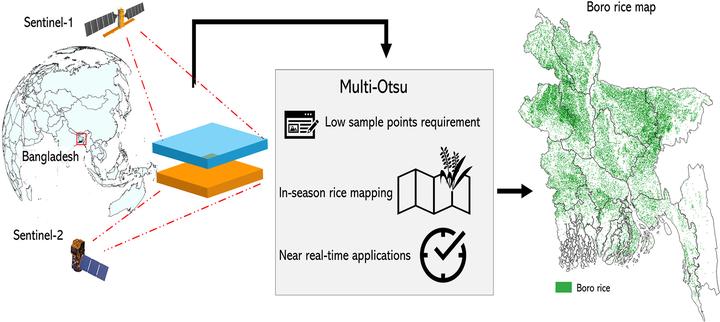Automated in-season rice crop mapping using Sentinel time-series data and Google Earth Engine: A case study in climate-risk prone Bangladesh
 Graphical abstract
Graphical abstractAbstract
High-resolution mapping of rice fields is crucial for understanding and managing rice cultivation in countries like Bangladesh, particularly in the face of climate change. Rice is a vital crop, cultivated in small scale farms that contributes significantly to the economy and food security in Bangladesh. Accurate mapping can facilitate improved rice production, the development of sustainable agricultural management policies, and formulation of strategies for adapting to climatic risks. To address the need for timely and accurate rice mapping, we developed a framework specifically designed for the diverse environmental conditions in Bangladesh. We utilized Sentinel-1 and Sentinel-2 time-series data to identify transplantation and peak seasons and employed the multi-Otsu automatic thresholding approach to map rice during the peak season (April–May). We also compared the performance of a random forest (RF) classifier with the multi-Otsu approach using two different data combinations; D1, which utilizes data from the transplantation and peak seasons (D1 RF) and D2, which utilizes data from the transplantation to the harvest seasons (D2 RF). Our results demonstrated that the multi-Otsu approach achieved an overall classification accuracy (OCA) ranging from 61.18% to 94.43% across all crop zones. The D2 RF showed the highest mean OCA (92.15%) among the fourteen crop zones, followed by D1 RF (89.47%) and multi-Otsu (85.27%). Although the multi-Otsu approach had relatively lower OCA, it proved effective in accurately mapping rice areas prior to harvest, eliminating the need for training samples that can be challenging to obtain during the growing season. In-season rice area maps generated through this framework are crucial for timely decision-making regarding adaptive management in response to climatic stresses and forecasting area-wide productivity. The scalability of our framework across space and time makes it particularly suitable for addressing field data scarcity challenges in countries like Bangladesh and offers the potential for future operationalization.